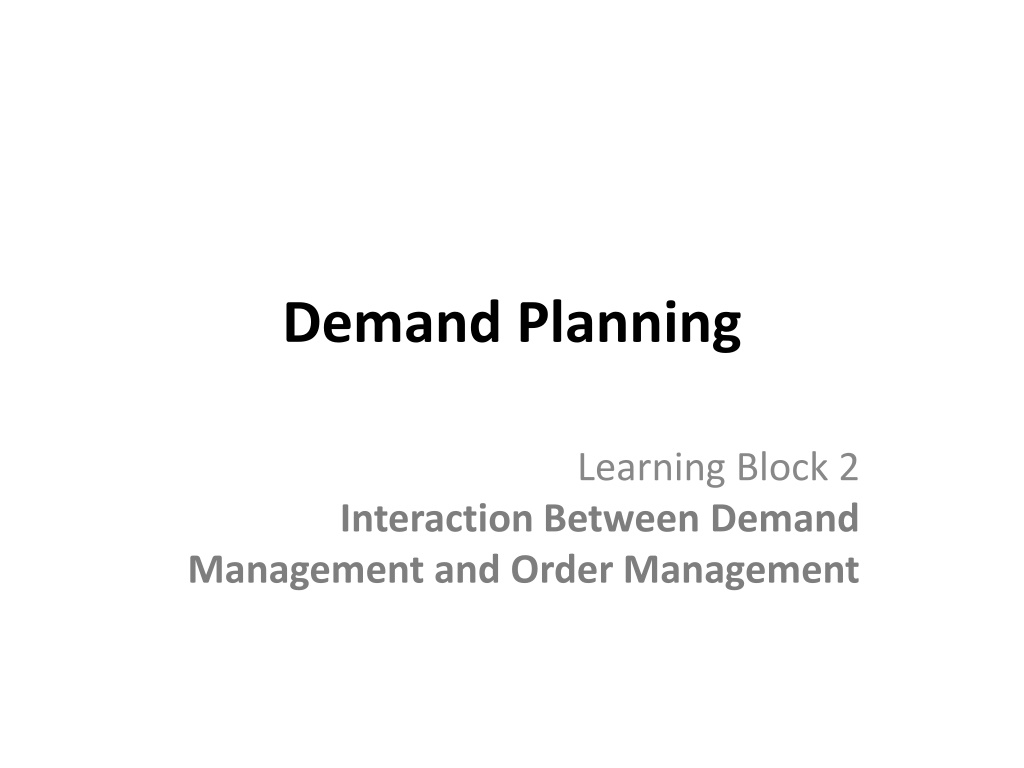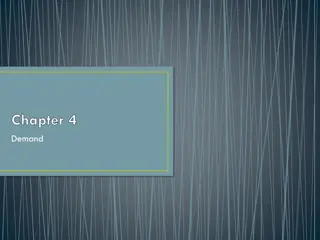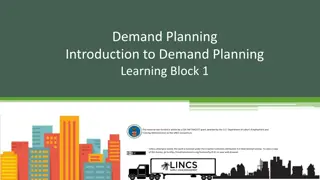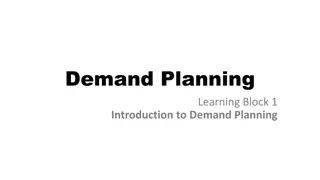Demand Planning and Order Management: Enhancing Efficiency
Explore the intricate relationship between demand planning and order management, crucial for optimizing customer order fulfillment cycles. Learn key principles, tools, and techniques to enhance communication and manage demand effectively, along with contemporary approaches and e-commerce fulfillment strategies. Dive into the essentials of order management, customer orders, replenishment cycles, and the role of e-commerce technologies in enabling efficient demand management. Achieve learning objectives focusing on recognizing order management aspects, understanding customer order cycles, evaluating demand management links, and implementing enabling e-commerce technologies.
Download Presentation

Please find below an Image/Link to download the presentation.
The content on the website is provided AS IS for your information and personal use only. It may not be sold, licensed, or shared on other websites without obtaining consent from the author. Download presentation by click this link. If you encounter any issues during the download, it is possible that the publisher has removed the file from their server.
E N D
Presentation Transcript
Demand Planning Learning Block 2 Interaction Between Demand Management and Order Management
Course Agenda 1. Introduction to Demand Planning 2. Interaction between Demand Management and Order Management 3. Demand Planning Principles 4. Demand Planning Tools and Techniques 5. Communicating and Managing Demand 6. Contemporary Approaches to Demand Planning and Management 2
Learning Block 2 INTERACTION BETWEEN DEMAND MANAGEMENT AND ORDER MANAGEMENT
Learning Block Agenda Unit 1: Overview of Order Management Unit 2: The Customer Order and Replenishment Cycle Unit 3: Demand Management and Order Management Unit 4: Ecommerce Order Fulfillment Strategies
Description Demand planning process-designed to create a plan that reduces uncertainty about when customer orders will occur in a defined period of time. Customer order management function- primarily concerned with managing customer orders and the customer order cycle from the time an order is placed until the order is received. 5
Learning Objectives Recognize the key aspects of the order management function Explain the key steps in the customer order and replenishment cycle Compare the key links between demand management and order management Evaluate the role of ecommerce technologies in enabling effective demand management Implement the key technologies that enable ecommerce
Unit 1: Overview of Order Management The customer order management function involves the handling of customer orders and managing the customer order cycle. The order management process begins with customer requests, which can range from broad questions to specific requests about particular products or services.
The Objective of Order Fulfillment The ultimate objective of order fulfillment is completing customer orders by the promised delivery dates at the right quantities and conditions, all while managing total costs. As with supplier selection and new product development, customer order fulfillment, if performed quickly and responsively, can aid a company s competitiveness
Unit 2: The Customer Order and Replenishment Cycle The customer order and replenishment cycle occurs when customers interact with suppliers such as wholesalers, retailers, or material suppliers and includes the work directly involved in receiving and fulfilling customers orders and in replenishing inventories.
Customer Request or Arrival The order management cycle begins when a customer requests information from potential suppliers.
Customer Order Entry customers inform retailers and suppliers about the products that they wish to purchase. The main objective is to ensure that order entries are accurate, carried out in a timely fashion, and communicated throughout the supply chain.
Customer Order Receipt Occur when customers actually receive and accept their orders. During this process, customers check the quantity and quality of delivered products, and any incomplete or damaged orders are recorded by the customer.
Customer Invoicing When customers place orders, they receive invoices Invoices state amounts owed and payment terms (e.g., number of days that customers have to pay the invoice, deductions for early payment or penalties for late payment, and the form of payment required)
Inventory Replenishment The process of determining when to make or buy more inventory and the volume to make or order and of considering cost and customer service trade-offs
Stocking Policies Companies often base their inventory stocking and replenishment policies on their desired service levels. Example: if a company wants a 98% service level, they must have enough inventory on hand to ensure that customers receive the product they want in 98 of every 100 visits to a store or website.
Unit 3: Demand Management and Order Management Demand management progresses beyond simple demand estimation and includes reactions to demand changes. Companies that excel in demand planning processes attempt to be proactive by influencing demand patterns through actively managing demand, rather than simply reacting to changes.
The Relationship between Demand Management and Order Management Sales organization needs to provide demand planners with details about expected orders from customers Demand management s work with order management can promote a balanced flow of goods across supply chains
Unit 4: Ecommerce Order Fulfillment Strategies Various technologies can be used to support the order management process within organizations including: telephone fax mail Internet electronic data interchange (EDI) barcoding point of sale (POS) technology radio frequency identification (RFID) OMS technologies
Practice Questions 1. The customer order management function is primarily concerned with: a. Managing internal customers only b. Developing production plans c. Managing the customer order cycle d. Managing suppliers
Practice Questions 2. Which of the following defines successful customer order fulfillment? a. Orders are filled and sent to suppliers on time, in the correct quantities, with no damage, and within the specified delivery date b. Orders are filled and sent to the distribution center on time, in the correct quantities, with no damage, and within the specified delivery date c. Orders are filled and sent to transportation on time, in the correct quantities, with no damage, and within the specified delivery date d. Orders are filled and sent to customers on time, in the correct quantities, with no damage, and by the specified delivery date
Practice Questions 3. Which of the following is the key starting point of the customer order management cycle? a. Customer order entry b. Customer request or arrival c. Customer invoicing d. Customer receipt of orders 4. Order entry occurs when a customer performs which of the following? a. Receives an invoice for products and services b. Receives and accepts orders c. Complains about customer service d. Informs retailers or suppliers about the products they wish to purchase
Practice Questions 5. After a sale, the replacement of an item previously held in inventory is called: a. Demand planning b. Selling c. An order receipt d. Replenishment
Practice Questions 6. Demand management attempts to: a. Influence customer orders while trying to reduce the uncertainty of when those orders will occur b. Reduce customer orders while trying to increase the certainty of when those orders will occur c. Influence customer orders while trying to increase the uncertainty of when those orders will occur d. Influence customer orders while trying to reduce the certainty of when those orders will occur
Practice Questions 7. Working in unison, demand management and order management can be: a. Detrimental to the company s success b. A way to promote a balanced flow of goods across a supply chain c. Stressful d. A way to promote a limited flow of goods across a supply chain
Practice Questions 8. Ecommerce is best described by which of the following responses? a. A wide range of techniques used to conduct business without paper b. Only EDI exclusively c. Events that could affect demand patterns d. Commerce that uses electricity
Practice Questions 9. Which technology features the direct exchange of information between computers? a. Internet b. EDI c. Fax machines d. Telephone 10. Which response describes when customer order receipt occurs? a. When customers actually receive and accept their orders b. When the order is placed c. When the invoice is paid d. When the order is shipped























